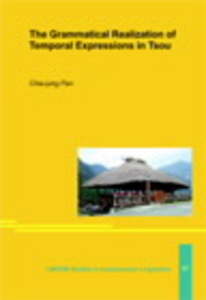The Grammatical Realization of Temporal Expressions in Tsou
Pan, Chia-Jung (2010) The Grammatical Realization of Temporal Expressions in Tsou. LINCOM Studies in Austronesian Linguistics , 7 . Lincom Europa, Munich.
![[img]](https://researchonline.jcu.edu.au/17258/2.hassmallThumbnailVersion/17258_Pan_2010_Book_Cover.jpg)
|
Image (JPEG) (Book Cover)
- Cover Image
Download (5kB) |
|
|
PDF (Front Pages)
- Supplemental Material
Download (2MB) |
||
|
PDF (Back Pages)
- Supplemental Material
Download (2MB) |
Abstract
This study proves an in-depth investigation of the grammatical realization (including semantic functions, temporal markers, grammatical roles, grammatical categories, and syntactic relationships) of temporal expressions in Tsou, an Austronesian language of Taiwan. Temporal expressions examined in this study are based on Haspelmath’s (1997) classifications of time adverbials and, meanwhile, with the addition of frequency expressions and miscellaneous temporal expressions, in order to scrutinize the semantic functions and their corresponding markings. Among the twenty-three subtypes of semantic functions, it is found that five temporal markers are employed in the markings with different types of semantic functions of temporal expressions: ne-, ho-, ta, to, and no. Besides, some semantic functions of temporal expressions in Tsou even take the form of ne or ho clause. These five markers and the ne or ho clause possess their own distinguishing temporal characteristics. It is also shown that the markers ta, to, and no are virtually oblique case markers, thereby suggesting that in addition to spatial and psychological distinctions, case markers in Tsou can distinguish temporal meanings as well.
Following Croft's (1991) function-indicating morphosyntax, it is shown that the categorial statuses of twenty-three subtypes of temporal expressions fall under the grammatical categories verb and noun. This analysis challenges the claim that adverbial concepts tend to be realized as verbs in Formosan languages (Starosta 1988). Nevertheless, the analysis towards frequency expressions is largely consistent with Zeitoun (1992) and H. Chang (2004); that is to say, frequency expressions surface as verbs.
Given idiosyncratic distributional properties, temporal expressions in Tsou can be divided into three groups. In group one, temporal expressions projected as NP and CP are restricted to occur in the position immediately before the subject, in the sentence-initial position, and in the sentence-final position. In group two, temporal expressions projected as VP are constrained to follow the preverb and simultaneously precede the main verb. In group three, the temporal expressions projected as TP are restricted to precede or follow the ho/ne clause. In addition, following Lehmann (1988) and Diessel (2001), temporal expressions in Tsou involving bi-clausal constructions (projected as CP (group one) and TP (group three)) are in a relation of clause linkage subordination, which is further treated as ADV-clause rather than COMP-clause and REL-clause.
This study is organized as follows. Chapter one introduces the background of this study. Chapter two provides a sketch of Tsou grammar. Chapter three scrutinizes the semantic functions and the markers of each of the temporal qualifications in Tsou. Chapter four discusses and analyzes the syntax of temporal expressions in Tsou, including grammatical roles, grammatical categories, and syntactic functions of temporal expressions. Finally, chapter five concludes this study.
| Item ID: | 17258 |
|---|---|
| Item Type: | Book (Research - A1) |
| ISBN: | 978-3-86288-011-9 |
| Related URLs: | |
| Date Deposited: | 19 May 2011 02:57 |
| FoR Codes: | 20 LANGUAGE, COMMUNICATION AND CULTURE > 2004 Linguistics > 200408 Linguistic Structures (incl Grammar, Phonology, Lexicon, Semantics) @ 100% |
| SEO Codes: | 95 CULTURAL UNDERSTANDING > 9502 Communication > 950203 Languages and Literature @ 100% |
| Downloads: |
Total: 2369 Last 12 Months: 57 |
| More Statistics |



